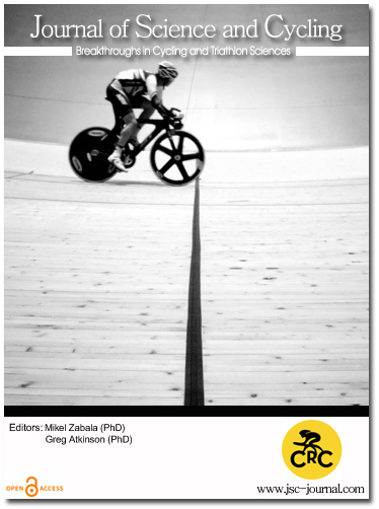Comparison of power output demands for a top-10 ranking between Tour de France and Vuelta a España
Abstract
Background: Grand Tours (GT) are extreme endurance cycling events with about 3500 km covered in twenty-one stages during three weeks. Using the heart rate measurement, Lucia et al. (Lucia et al., 2003: Medicine & Science in Sports & Exercise, 35(5), 872-878) showed that the total exercise load (volume x intensity) do not differ between the Tour de France (TdF) and Vuelta a Espana (VaE). Since powermeters are daily used by the professional cyclists, there are some studies which investigated power output (PO) during Grand Tour but none has made PO measurement on a top-10 overall ranking cyclist to compare PO in different intensity zones in TdF and VaE.Purpose: The purpose of this study was to compare the physical performance level between TdF and VaE of a top-10 overall ranking cyclist from PO measurements. Methods: The PO data of a cyclist (23 yrs, 180 cm and 65 kg) who finished in the top-10 overall ranking in TdF 2012 (10th) and VaE 2013 (7th) were analysed to evaluate the physical performance level on each race from 1/ the determination of the Record Power Profile (RPP) of TdF and VaE according to the methodology of Pinot and Grappe (Pinot & Grappe, 2011: International Journal of Sports medicine, 32, 839-844) and 2/ the comparison of the maximal efforts in the five exercise intensity zones defined from the RPP.Results: Figure 1 shows the RPP of the cyclist in TdF and VaE. The performance level in the low part of the severe intensity (zone 3) is similar in the two GT (Table 1). In the heavy intensity (zone 2) there is a slight increase (+1.6%) of the performance level in VaE. The level of performance in moderate intensity (zone 1) and in force-velocity (zone 5) are higher in the Tdf (5.1% and 2.6%, respectively) while it’s the opposite in the high part of severe intensity (zone 4) (+6.9% in VaE).Discussion: This study shows that the maximal efforts made between 5 and 60 min both in the TdF and VaE are very close in a top-10 overall ranking. This result means that the cyclist performed in the heavy and in the low part of the severe intensity zones at the same physical level of performance in the two GT although the characteristics of the roads were different (11 summit finishes & 36 km of individual time trials (ITT) in VaE 2013 vs. 4 summit finishes in Tdf 2012, longer stages (+8%) and 100 km of ITT). The results are in accordance with the specificity of the efforts performed between the maximal aerobic power (MAP) and the anaerobic threshold to get a ranking in the top 10 in a GT. Indeed, the general classification in a GT usually plays in mountain ascents and during ITT. The shorter and steeper finish ascents in VaE could explain why the record PO between 30 sec and 5 min were higher than in TdF. The higher level of performance in TdF in moderate intensity is due to a long breakaway of the cyclist performed to go win a stage. Conclusion: To achieve an overall ranking top 10 in a GT, the level of performance in the heavy and in the low part of the severe intensity zones is essential. To get there, the levels of both MAP and anaerobic threshold must be the highest possible.Downloads
Published
How to Cite
Issue
Section
Copyright (c) 2014 Journal of Science and Cycling

This work is licensed under a Creative Commons Attribution-NonCommercial 4.0 International License.
Authors contributing to Journal of Science and Cycling agree to publish their articles under a Creative Commons CC BY-NC-ND license, allowing third parties to copy and redistribute the material in any medium or format, and to remix, transform, and build upon the material, for any purpose, even commercially, under the condition that appropriate credit is given, that a link to the license is provided, and that you indicate if changes were made. You may do so in any reasonable manner, but not in any way that suggests the licensor endorses you or your use.
Authors retain copyright of their work, with first publication rights granted to Cycling Research Center.






